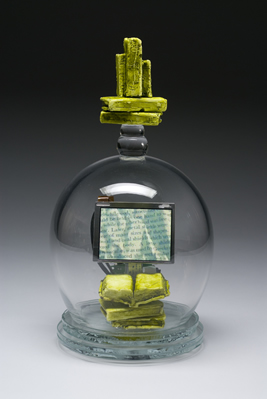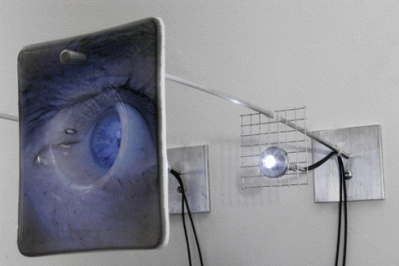 Tim Tate, Memories of Reading, 2008. Blown and cast glass, electronic components, original video. H 14, W 6, D 6 in.
Tim Tate, Memories of Reading, 2008. Blown and cast glass, electronic components, original video. H 14, W 6, D 6 in.
“The New Materiality: Digital Dialogues at the Boundaries of Contemporary Craft,” an exhibition now on view at the Fuller Craft Museum in Brockton, Massachusetts, (and running through February 6, 2011) seeks to document the mixing of digital technology and artwork made from craft materials. Independent curator Fo Wilson, who is also an assistant professor at the University of Wisconsin Milwaukee and a furniture designer, frames this mingling of handmade objects and digital, often mass-produced media, as less a meeting of disparate points of tension and conflict than, as Wilson writes in the curatorial essay in the exhibition catalog, a simple bringing-together of more diverse materials that effectively expands the range of possibility for the craft field. Wilson clearly wants to expand the very definition of craft-based work to include the utilization of mass-produced technology. As she writes in her catalog essay: “the exhibition … examines the work of sixteen established and emerging makers working within established craft disciplines or with traditional craft materials who are treading compelling territory between their mediums and emergent technologies.”
The works themselves, however, indicate a certain hostility to this technological integration, rather bearing witness to a tension that refuses material resolution, not only between the hand-made and the machine-made but in the very notion of contemporary craft as a proposed unification of physical crafting, mass-produced digital media, and conceptualism. What it amounts to is no longer simply “craft,” but a more freewheeling, concept-driven practice in which diverse materials are up for grabs, and where organic materiality is just one strategic choice among many. In other words, the practice of contemporary art.
Tim Tate’s Memories of Reading (2008) pictured above provides a case in point. Constructed from blown and cast glass as well as electronic components and video, the piece asserts a certain primacy of craft through the glass enclosure of a video screen and its wiring. The screen itself shows the image of a tattered page of a book, both celebrating the act of book-reading and memorializing it as a relic of an earlier age, viewed like a documentary of some distant past encased in glass like a dead specimen. A material process, glass-blowing takes on the function of enclosing something organic (the book) that is pronounced dead, but presented through a digital medium that, in turn, is treated as something dead when seen through glass. Which is to say, new and old media traverse each others’ histories in the eerily a-temporal space of the art-object.
What is uncanny about the piece is precisely how the video screen stands out from the crafted materiality of the glass case and the book-shaped glass sculptures adorning it, how it resists the craft aesthetic: the self-assured confidence of an unblinking digital eye in the midst of an other world, as if to say “I’m not going anywhere, though the old world will collapse around me.”
 Brian Boldon, Looking and Blindness, 2006 (detail). Kiln-formed glass, aluminum, steel, digital glass prints, LEDs. H 56, W 11, D 8 in.
Brian Boldon, Looking and Blindness, 2006 (detail). Kiln-formed glass, aluminum, steel, digital glass prints, LEDs. H 56, W 11, D 8 in.
This juxtaposition of worlds, which posits not a new sphere for the craftsman’s expertise, but rather elements of resistance to craft as such, to the hand-made, to the organic, is frequently a central aspect to the works in “The New Materiality.” Another such standout is Brian Boldon’s Looking and Blindness (2006), in which digital images of (real, not symbolic) eyes stare out from panels illuminated with harsh white light. Here, the human element is stripped of its context, latched onto a sterile machinery, which in turn humanizes the machine. At the same time, the glass, aluminum, and steel formed with traditional techniques that make up the structure disassociate the materials from an organic context, appearing more like the sleek, streamlined work of an industrial process — the craft, the human element, intentionally hides itself in the mechanical, in effect dehumanizing the hands that made the piece.
If this belongs to the same Craft Movement or practice that sees itself as a reaction against the dehumanizing effects of technology, or as a reaffirmation of human values against encroaching, anti-human forces, the inclusion of this piece under the banner of ‘contemporary craft’ indicates, to me at least, that craft itself might have an identity problem.
In her curatorial essay, Wilson writes that “digital technology is part of a new materiality in craft. These new technologies are not displacing components of craft’s heritage, but adding to them and enriching craft expression.” The basic idea seems to be that digital technologies are merely becoming new materials for craft, worked on from the craft perspective. But as the works in the exhibition illustrate, this “new materiality” is in fact a space where fundamental (and, I think, unresolvable) tensions co-exist between the hand-made and the machine-made, between craft itself and other, possibly hostile currents, meaning that the works in “The New Materiality” are far beyond a delimited discourse on contemporary craft, embracing the sort of mixed-media blurring in play in contemporary art as such.
As a certain perspective within contemporary art, the idea of craft holds genuine value in its emphasis on a physical relationship to hand or tool-crafted material. But to designate this space as ‘contemporary craft’ seems to me to be a form of self-imposed exile, when its practice is so closely aligned with (and often, virtually indistinguishable from) the broader space of contemporary art.
Predictably, the artists themselves in the exhibition do not appear to care so much about craft-theorizing, and their work is the better for it. Rather than promoting an autonomous sphere of craft-work, the art-works tend to situate themselves at points where hand-craft and mass-produced digital media do not harmonize into a “new materiality,” but exploit the sense of non-harmony between craft and non-craft. This meeting-space is precisely that of the art-object — a space that, ever since Manet (and perhaps even before him) has been a site of tension, not resolution.
—Lee Gaizak Brooks


